San Pedro de Atacama, Chile: Martian Landscape, Dry as a Bone and AWESOME!
Jun 17, 2015
I loved San Pedro de Atacama, like really loved it. It was no doubt one of the best places in South America. Again, it was a bit of a tourist trap in that the place runs nearly 100% on tourism but it wasn’t as annoying as you might expect. No one was following us down the streets trying to sell tours or forcing unwanted pamphlets into our hands like you might encounter in other places like Cusco, Peru. Everyone was doing well enough just letting the business come to them and with the easily accessible sights just outside of town, it’s no wonder why. The landscape is otherworldly and the night sky is so clear you’ll find it hard not to give yourself a soar neck every night.
 |
| A wide panoramic of the landscape with roughly 15 volcanos doting the horizon. |
First, let’s talk about the landscape. As you can see from the photos, it’s a bit unusual. The lack of precipitation and baking intensity sun leaves the land looking hard and petrified but in fact, it’s covered in dusty salt and kind of brittle. It’s basically a salt flat surrounded by mountains and volcanoes that doesn’t really experience any seasons. It receives just 8 or 9 hours of daily sunlight all year round so you don’t have short days in winter and long days in summer and, the intensity of the sun is staggering. You really need to cover up as much skin as you can and wear plenty of sunscreen. Given the high demand for sunscreen and remoteness of the area, however, sunscreen is sold at ridiculously high prices.
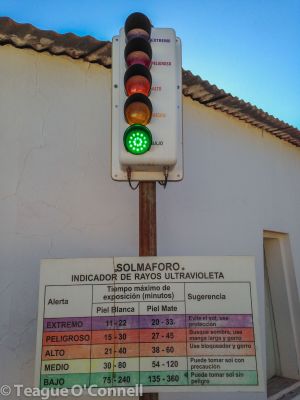 |
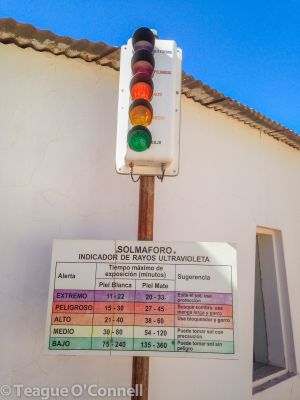 |
| Early morning UV index. | Late afternoon UV index. |
Even though it’s the driest place on earth, it will rain in some areas but it isn’t common. In some regions, the last recorded rainfall was more than 130 years ago.
We explored the area mostly by bike. We left early each day to avoid the worst of the baking sunshine which meant venturing out into the darkness of the still dissert every morning in freezing temperatures. Once the sun came up though, you were warmed right up but not enough to remove all the layers you put on when you set off. You might think biking in the roasting sun would be a hot and sweaty affair but the air was actually quite cool and the dry atmosphere instantly evaporated any hint of sweat that might come from all your effort. In these conditions, bringing lots of water and staying hydrated is an absolute must.
One famous fact that has given the area a little additional notoriety is that NASA tested a duplicate of one of the Mars rovers here. The dry lifeless regions of the area are considered to be the most Martian like places on the planet Earth. Cool, right?
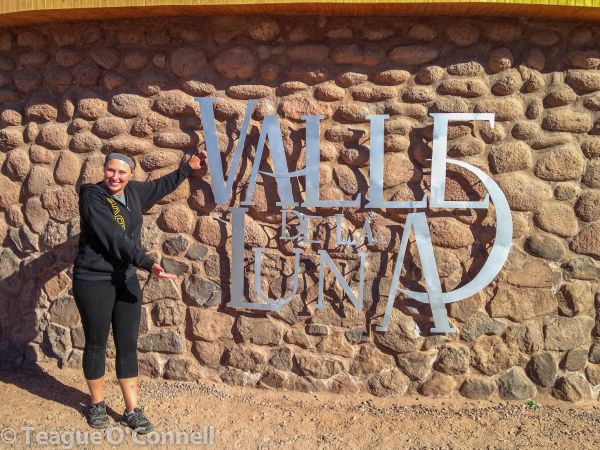 |
|
At the entry office early in the morning. Jen is layered up because its cold but the sun is REALLY intense. |
The areas we biked were the Valley of the Moon and the Devil’s Valley, both noteworthy for their extreme landscapes and arid lifeless features. The Valley of the Moon is bizarre looking. It has crazy features like whole parts of what might have been a part of the earths crust sticking up from out of the ground in jagged formations. It also has these dust and dirty covered salt boulders and caves which you have to see with your own eyes to believe. During our ride, we covered some serious distance but it was all worth it when we reached the end of the valley and hike up to the edges of the overlooking the salt-flats with views of the mountains and volcano’s in the distance.
While up there exploring Jen found a small piece of broken pottery on the ground. It looked old so we looked around some more and found more pieces in the same area. We fitted some together and realized we were holding what might be an artifact. We did our best Indiana Jones and then decided it belonged in a museum. Later, however, someone mentioned that the place we found it was a creek with a waterfall about a thousand years ago and that the area is littered with broken bits of ancient pottery. The only artifacts people cared about in the area were the whole clay pots or pieces of the ceremonial ones. Apparently they are not that uncommon given that the current town sits on the site of a once prosperous pottery-making hub from long ago. Our Hostel even had a few collecting dust that you could pick up and have a look at. Oh well, no Holly Grail adventure for us but it was still really cool.
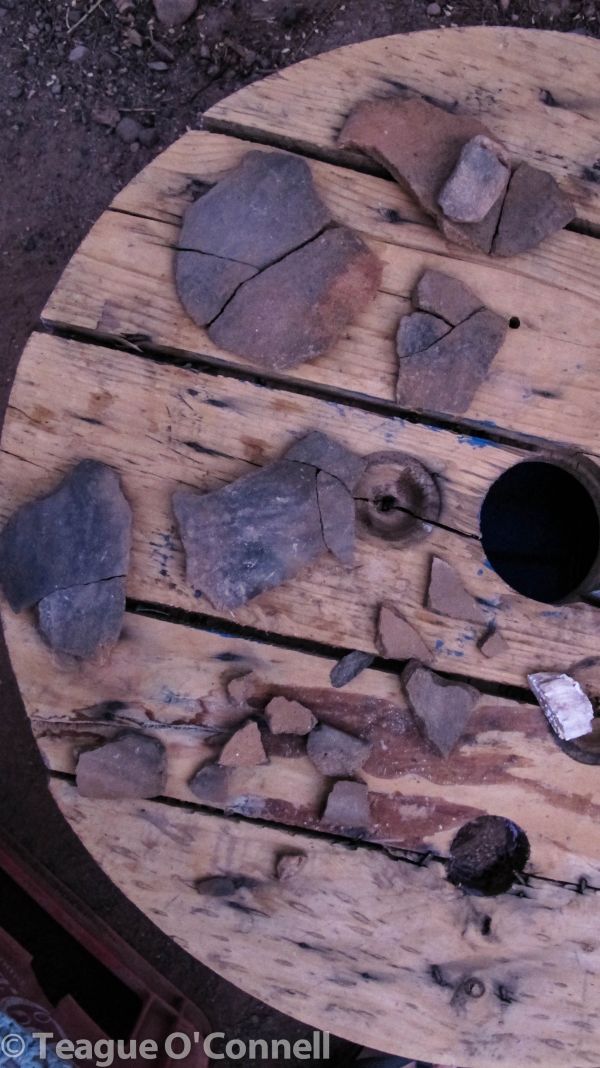 |
| Pottery bits found during our ride. Quite common from what we were told but really cool nonetheless. |
The Devil’s Valley is interesting and again, a steep ride/slog over sand dunes which especially sucked at times because the biked were so heavy and unmanageable on the dunes. Once we reach the top though and excited the valley we were at a fantastic viewpoint called the Piedra del Coyote. This really was a jaw-dropping place with views of the Moon Valley and the Andean range stretching from North to South from horizon to horizon. We arrived well before sunset and had it to ourselves for about an hour where we took these photos. About 30 minutes before sunset the tour groups showed up by the busload and it became a bit busy but it was hard to take anything away from the area.
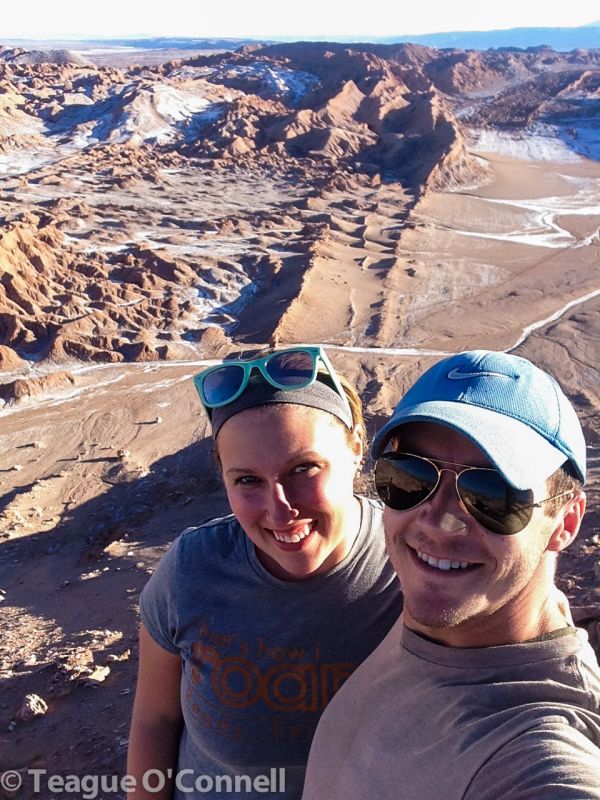 |
| Thats not snow in the background, its salt.There was once an ocean here. |
Our naked-eye stargazing up to this point was excellent but it got even better when we took an observatory tour on our last night in town. It wasn’t as good as the one in Pisco Elqui but it was still very cool and my first go at looking through a REALLY nice and very expensive fully automated observatory telescope. We snapped a few photos and spent about 3 hours staring through lenses at different Clusters, Stars and Planets. The only let down was that I wasn’t able to get tickets for the ALMA Radio Telescope tour that is run by the American/European owners for a small fee. ALMA is short for Atacama Large Millimeter Array, which is the world’s largest diameter individual radio telescope. It’s one of many Array’s and Observatories in the area but is well known for it’s studies of planetary formations and other galaxies. Going to a place where they watch Galaxies far, far away… who doesn’t want to do that?
When I go back to Chile, it’s pretty likely that I’ll try to make another stop in San Pedro de Atacama. I felt pretty good leaving knowing that I probably saw the best of it but I sure wouldn’t mind doing some more Star Gazing. If you ever find yourself there and have the means, check into the private observatories that offer accommodation. I heard they were great for all levels of interest/experience and a top choice for families.
Please add a comment
Leave a Reply
Category List
Accommodations (8)
Products (11)
Places (24)
Activities (11)
Photo Album (35)
Photo Essays (1)
Resources (6)
Tag List
Waterfalls (1)
Tours (2)
Belize (1)
Tulum (1)
Costa Rica (1)
RTW travel for women (4)
Mini-retirement (1)
Travel (4)
Planning Your Trip (1)
Ecuador (2)
Career Break (2)
birth control (1)
Living abroad (1)
RTW Travel (9)
Tulum Ruins (1)
Mexico (1)
Hostels (4)
Recommendations (2)
Central America (2)
Stretch your money (1)
birth control and traveling (1)
Salt Flats (2)
Sunday Funday (1)
Caye Caulker (1)
Yoga (1)
Biking (1)
Hiking (2)
Flores (1)
Panama (2)
Nicaragua (1)
Travel Workout (1)
Guatemala (1)
Bolivia (2)
Traveling into Panama (1)
Family (2)
Cotopaxi (1)
pack, Deuter, Gregory, women (1)
Utila (3)
Scuba Diving (1)

